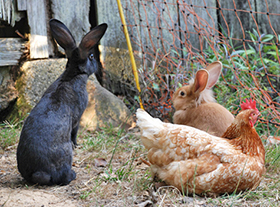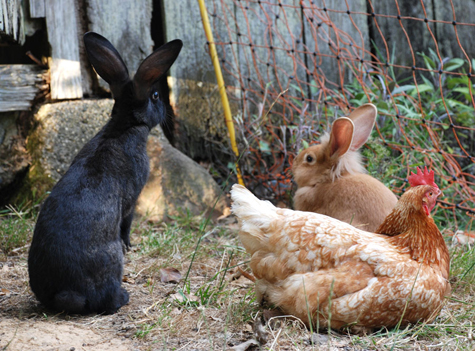More progress for on-farm poultry processing in Texas

Successfully advocating for a cause such as family farms and local foods means focusing on the long haul, speaking up consistently, building relationships, and “showing up” – being there, day after day, year after year. It can be discouraging sometimes … and sometimes it pays off in unexpected ways, as in a recent proposal by Texas’ Department of State Health Services (DSHS) that builds on gains FARFA made for small-scale poultry and rabbit farmers last year.

Until 2019, it was extremely difficult for small farmers in Texas to process their poultry on their own farms. Although federal law provides for on-farm processing, Texas was one of the few states that had stringent limits: Anyone wanting to process so much as a single chicken on their farm had to build a facility that met the federal requirements for commercial slaughterhouses. This cost-prohibitive regulation was also applied to small-scale rabbit farmers.
In 2019, FARFA successfully pushed for passage of a bill to remove these barriers for very small farms. The resulting law allows on-farm processing of up to 500 rabbits and 1,000 chickens with minimal requirements. You can read more about it HERE. This was a major breakthrough, allowing small farmers to provide poultry and rabbit meat for their local communities with minimal start-up costs.
And now the work to pass that bill has yielded more benefits! During our executive director’s testimony to the Public Health Committee, she set out how the agency’s current regulations impose requirements that go beyond the state statutes and were never intended by the Legislature.
The (at-the-time-new) Assistant Commissioner for DSHS listened. And after Session, we continued the discussion with him about the problems with the agency’s current regulations.
Last Friday, DSHS proposed new regulations. The proposed regulations address the bill we got passed AND reforms the requirements for those farmers who process more than 500 rabbits or 1,000 poultry on-farm (up to 10,000 rabbits and/or poultry per year).
A farmer processing over 500 rabbits or 1,000 poultry must register with DSHS and develop a Sanitary Operating Procedures Plan, which is a long-standing statutory requirement. But the proposed regulations delete the requirement for these small farmer-processors to meet the regulations that apply to commercial slaughterhouses! They also remove the provisions for agency inspections before the farmer-processor starts. In practical terms, that means that the agency will only come inspect if there is some complaint or other cause.
The farmer must operate under sanitary conditions, and what constitutes that could be a source of disagreement if there is a complaint that triggers an inspection. But this is a HUGE step forward. If the rules are finalized in their current form, it means farmers will be able to process up to 10,000 rabbits and/or poultry of their own raising each year, and sell the meat direct to consumer or wholesale within Texas, without having to spend tens of thousands of dollars in building an unnecessary commercial-scale facility.
The proposed rule adds some new labeling requirements for these farmers, essentially making the on-farm labels include the “safe handling” provisions you see on conventional meat in grocery stores.
You can read the proposed regulations HERE. The first section deals with rendering and transporting dead livestock – the meat processing section begins on page 17 of the PDF, with the main section on low-volume poultry/ rabbits (which is now defined to cover the folks doing more than 500 rabbits/ 1,000 poultry, but less than 10,000) are on pages 26 and 31-32.
The agency is accepting public comment until September 28. After that, the staff will review the comments, consider any changes, and then publish the final rule. You can send comments to Brandon Rudloff, meat.regulatory@dshs.texas.gov. Indicate “Comments on Proposed Rule 20R013” in the subject line.
Read FARFA’s comments to DSHS on the proposed new rules HERE.